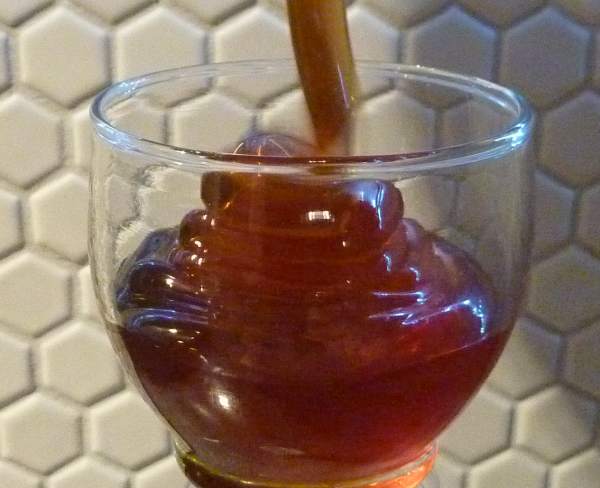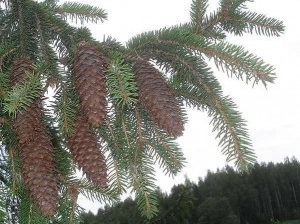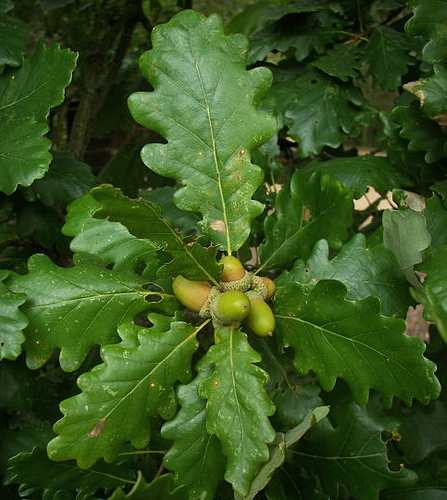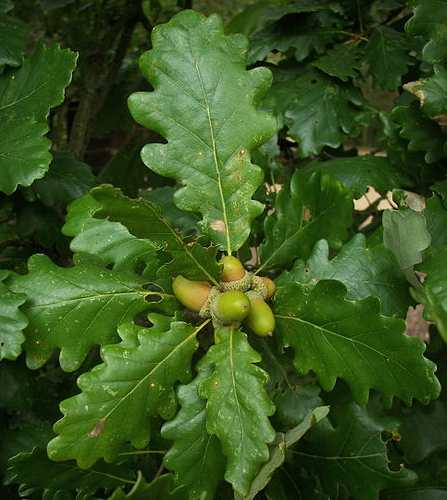When honey bees create honeydew or forest honey, they don’t start with sweet nectar gathered from flower blossoms. Rather, they create this unique honey with another sweet substance called honeydew—produced by aphids. This sweet substance is a natural waste product excreted by aphids as a byproduct of consuming plant sap. The aphids eat the sap not so much for sugars but for the amino acids it contains. This means that most of the sugars are expelled by the aphid as honeydew, a substance that bees love (ants too).
Since honeydew is chemically different from nectar, honeydew honey is also chemically different from regular blossom honey. It is usually darker with a higher mineral content, and has with a stronger taste and particular nutritional/therapeutic benefits. It is highly prized in Europe but is relatively unknown in North America. Given the prevalence of aphids world-wide, it may not be surprising to learn that much blossom honey from around the world contains some percentage of honeydew honey.
Honeydew honey comes in many varieties depending upon the type of plant and the species of aphid; but the ones that find their way onto our table are typified by a consistent production and a large quantity of honeydew that is attractive to bees. What exactly is honeydew honey and how is it different from blossom honey?
Typical types of honeydew honey

|

|

|
|

|

|

|

|
Silver fir honeydew honey (Abies alba)
Is considered as one of the best honeydew/ forest varieties in Europe particularly in central Europe where it is widespread. The aphids responsible for its production belong to the Cinara genus. In Italy this honeydew variety comes from the Alps and the Apennines of Tuscany. In Germany from the Black and Bavarian Forests. An excellent table honey that goes well with cheese.
Mention should also be made of the Greek fir honey, which represents about 5% of total honey produced in Greece. The honeydew produced mainly by the insect Physokerames hemicryphus from the Greek Fir tree – Abies Cephalonica. Turkey too is known for Turkey fir honey derived from the Abies bornmulleriana trees in Marmara region as well as the Uludag mountains situated about 500 km north east of Ankara and 300 km south of Istanbul.
Characteristics:
Color: Dark amber to nearly black, sometimes with greenish shade
Taste: Low sweetness, medium intensity aroma, piquant
Odor: Between medium and high intensive, balsamic, herbal, resin, pine, malty, putrid vegetable, incense, caramel
Translation: German:Weißtannenhonig or Schwarzwald-Tannenhonig; French:Le miel de sapin or miellée de sapin, Le Miel de Sapin des Vosges*, Miel de Sapin Pectine, Miel d’épicéa; Italian: Il miele di abete or Il miele di abete bianco or melata d’abete bianc; Turkish: Köknar balı; Greek: Mέλι ελάτης, Μέλι Ελάτης Βανίλια Μαινάλου**; Spain: Miel de Abeto; Slovenian: Hojev med, Croatia: Med medljikovac
*Le miel de Sapin des Vosges (AOC): Honeydew from the Vosges Fir or Silver Fir (Abies pectinata or Abies alba) grown in Meurthe-et-Moselle, France.
** Μέλι Ελάτης Βανίλια Μαινάλου (DOC): Fir Honey Vanilla Mainalon. Honeydew from the fir trees of the mountain area, Mainalon, in northern Arcadia, Greece
Further Reading:
Hoping for “Pine’ Honey – Miellée de sapin in France (French translated to English)
Closeup of the aphid (French translated to English)
![]() Pine Honeydew honey (Pinus species)
Pine Honeydew honey (Pinus species)
Pine honey is a unique honeydew honey, produced mainly on the Aegean side of Turkey and Greece and introduced to the Italian island of Ischia. The scale insect, Marchalina hellenica, lives on the sap of pine trees and produces prodigious amounts of pine honeydew. Some people question the effect of this insect on the health of the tree, while others encourage “incoulation” of pine trees with this insect to produce pine honey. There is a debate about whether the Marchalina Hellenica is weakening the pine trees and should be controlled with the use of pesticides or to whether to continue ‘inoculating’ trees with it to produce honeydew for honey.
Characteristics:
Features are the reddish brown color, malty, spicy aroma. Woody flavor, slightly caramelized. Rich in minerals and does not crystallize quickly. From Turkey, Black pine honey (Siyah çam balı) is even richer, thicker and darker.
Turkey: Bee colonies foraging on forest plants, especially on Turkish Pine (Pinus brutia) and Stone Pine (Pinus pinea), yield about 50% of the total honey production. In this particular case, honey is being produced from honeydew of the insect Marchalina hellenica. Bee colonies are transported from all parts of the Turkish country to the lavish pine forests. September and October are the most plentiful months.
Greece: It is estimated that 60% of honey produced in Greece is Pine Honey mainly from the pines; P. brutia and P. halepensis. Pine honey is produced by the insect, Marchalina hellenica (known as “the worker” by Greek beekeepers) on the mainland in Southern Greece (Peloponnese) and also on some of the islands. The spring version of the honey is lighter than fall.
Translations: Greece: Πευκόμελο; Turkey: Bal çam; German: Tannenhonig; French: Miel de sapin; Italian: Miele di abete; Slovenian: Smrekov med;
Image credit:
Picture of Turkish pine thanks to Leonid Mamchenkov on Flickr and Ookaboo!
![]() Spruce honeydew honey (Picea abies)
Spruce honeydew honey (Picea abies)
An excellent honey, mainly produced in Europe, Slovenia and Czech. In Italy this honeydew comes prevalently from the Alps area. The piercing and suction insects most involved in the production of this honeydew belong to Cinara coslala, C, piceae and Physokermes hemicryphus. Coincidentally, the worlds oldest tree is a Norway Spruce called, ‘Old Tjkko’ in Sweden.
Characteristics:
Color: Amber color from light to dark, sometimes with reddish veins.
Aroma: Smoke, caramel, condensed milk, cooked, malted, panna cotta, resinous, a little balsamic
Taste: Medium intensity, slightly sweet and persistent. It remains liquid for a long time, it is very sticky and rarely fully crystallizes.
Translations: Germany: Fichtenhonig; Italy: Miele di abete rosso; France: épinette miel; Slovenian: smrekovega medu; Czech: smrkové medovice
Image Credit: By Sanja565658 (Own work) [CC-BY-SA-3.0 or GFDL], via Wikimedia Commons
![]() Oak-tree honeydew honey (Quercus species)
Oak-tree honeydew honey (Quercus species)
While it is obtained periodically in good quantities, some feel its quality is inferior to spruce and silver fir honeydew. Unusual for honeydew, Oak honey made with oak-tree honeydew does not remain liquid for long; it crystallizes firmly, forming large crystals. Oak-tree honeydew is quite common in central and southern Italy, but also found in France, Greece, Bulgaria (Sessile oak Quercus petraea), Croatia, Serbia (Chestnut oak Quercus petraca) and Slovakia. Holm oak (Quercus ilex L.) honeydew is probably the worst of the oak honeydews, The insects, which play the largest role in oak-tree honeydew production, are Tuberculalus annulalus, and T. borealis.
A rare type of Oak Honeydew honey made without insects comes from Croatia from the Italian or Hungarian Oak Q. frainetto in the Požega valley region. Every 5 to 8 years the production of acorns increases and as a consequence, a sweet sap is produced in copious quantities. At the same time, an Oak honeydew honey is collected with characteristics atypical for Honeydew honey; no special honeydew sugars and low conductivity. Confirmed by historical records this is a plant-originated honeydew used directly by bees for honey, with no mediation of plant-sucking insects.
Characteristics:
Aroma: Intense.
Taste: Very spicy and not too sweet sometimes a slight taste of licorice and mint. The darker its color, the more its aromatic flavor. At first completely clear and fluid, but it soon firms up and crystallizes fairly quickly.
Translations: Germany: Eiche Honig or Eiche Waldhonig; France: miel de chêne or miel de miellat de chêne; Italian: Quercia miele or Miele di melata di quercia; Spain: Miel de roble or Roble miel de mielada; Slovenian: Hrast medu; Bulgarian: мед дъб; Greek: μέλι δρυός; Croatia: Hrastove medljike
Image Credit: By Willow (Own work) [GFDL, CC-BY-SA-3.0 or CC-BY-2.5], via Wikimedia Commons
![]() Melcalfa pruinosa (Say) honeydew honey
Melcalfa pruinosa (Say) honeydew honey
Named after the insect that produces the honeydew, Metcalfa pruinosa (Say), the common name is the citrus flatid plant hopper. This is a relatively new type of honey in Europe as the insect was introduced in the late 1970s and has spread to Italy, France and Slovenia. In addition to citrus, it feeds on over 200 kinds of plants, both wild, ornamental and cultivated. The host plant has a strong affect on the characteristics of the honeydew and resulting honey. Some feel that honeydew from Linden or Maple tree produce better quality honey. It is rich in di- and trisaccharides, in particular maltotriose and shows the highest acidity and diastase values.
Characteristics:
Color: Dark amber to almost black.
Odor: The intensity of odor is medium with warm, vegetal and fruity like cooked fruit.
Taste: Moderately intense, low or medium sweetness, slightly salty, fairly persistent.
Translations: Italian: Melata di Metcalfa; France: Miel de Metcalfa; German: Metcalfahonig; Greek: μετκάλφα
![]() Beech or Beechwood honeydew honey (Nothofagus fusca) from New Zealand
Beech or Beechwood honeydew honey (Nothofagus fusca) from New Zealand
Both the Nothofagus fusca Red Beech and the Nothofagus solanri Black Beech are endemic to New Zealand and found in the South Island of New Zealand. The vast majority of New Zealand beechwood honeydew comes from these two species of Beech. The insect partners are actually Ultracoelostoma assimile and Ultracoelostoma brittini, both of which feed on the Nothofagus species. Beechwood honey has an malty, earthy flavor, intense odor and a rich amber color. It is a thick, smooth honey with low sweetness and medium persistence that will stay liquid and not crystallize easily. It is good in savory sauces and with fresh cheeses such as ricotta, or drizzled over figs or served with plain yogurt.
![]() Willow-tree honeydew honey (Salix species)
Willow-tree honeydew honey (Salix species)
An excellent honeydew with a small-scale production in Piedmont, Tuscany and Umbria. Also found in Lithuania, Spain, Scandinavian countries and Croatia. The insect medium is Tuberolachnus salignus.
Image credit: By MPF Attribution-ShareAlike 3.0 Unported (CC BY-SA 3.0)
![]() Citrus honeydew (Citrus species)
Citrus honeydew (Citrus species)
A very tasty honeydew honey produced from citrus trees by the insect, Rinchota. Produced in abandoned Citrus groves from Calabria and Sicily and from Tunisia.
By Ellen Levy Finch (Elf) (Own work) [GFDL or CC-BY-SA-3.0], via Wikimedia Commons
——————————————————
Further reading:
Aphids and white flies – bumblebee.org
Manna: Religious/Historical – Wikipedia









I am a health practitioner and I like to know the tested benefits if the Oak honey please as well as the other types if possible.
Hello Honey Traveler,
Great work! I good friend has found me some honey from a white flower that grows on fir trees in Romania – but he doesnt know the name! any idea to what it could be ? Are there any chances it is not ivy?
I suspect it’s either honeydew or ivy, but I thought it would be worth asking you.
Thanks
Nicholas
Hi like to know what much much more nutrition is on this special kind honey?
thanks